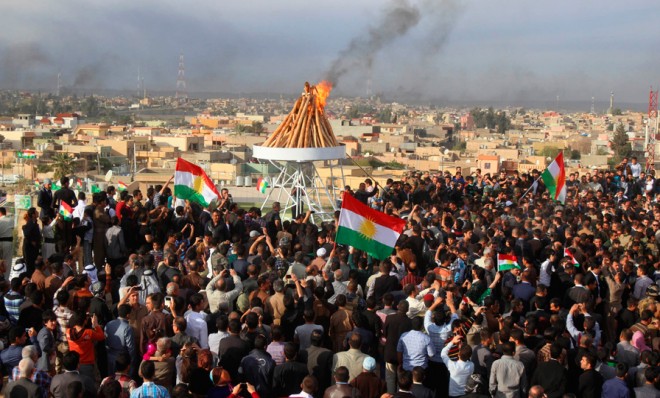Rosh Hashanah and 4 other New Years not on Jan. 1
Expand your horizons beyond the Gregorian calendar

Jewish New Year (Rosh Hashanah)
Tonight marks the eve of the Jewish New Year, Rosh Hashanah. In Hebrew, Rosh Hashanah means "head of the year." Judaism follows a "luni-solar" calendar — we're about to enter the year 5774 — and Rosh Hashanah always begins on the first day in the month of Tishrei. It marks the beginning of the High Holidays, which includes Yom Kippur, the "day of atonement." Jews celebrate Rosh Hashanah with apples to represent the round year ahead, and honey to signify their hopes for sweetness. Pomegranates are also popular for a number of reasons, including that myth that there are 613 seeds in a pomegranate to match the 613 commandments of the Torah. Jews also follow the tradition of Taschlich, symbolically casting their sins of the past year away by tossing breads or pebbles into a pond and saying prayers.
Islamic New Year (Ras-as-Sanah al-Hijriyah)
The Week
Escape your echo chamber. Get the facts behind the news, plus analysis from multiple perspectives.

Sign up for The Week's Free Newsletters
From our morning news briefing to a weekly Good News Newsletter, get the best of The Week delivered directly to your inbox.
From our morning news briefing to a weekly Good News Newsletter, get the best of The Week delivered directly to your inbox.
Muslims follow a lunar calendar that starts from 622 A.D., when the prophet Mohamed fled Mecca to escape religious persecution and headed to what is now Medina. While some Muslim countries celebrate the start of Muharram, the first month, as an official holiday, others treat it as a regular working day. Celebrations are relatively low-key, especially when compared to the festivities for Ramadan. Nov. 4 will mark the start of the 1435 year on the Islamic calendar.
Persian New Year (Nowruz)
Since the Persian calendar starts on the first day of the vernal equinox, Nowruz, which literally translates to "New Day," marks the start of spring. Though it is partially rooted in Zoroastrianism, Nowruz is a secular holiday that has been celebrated for over 3,000 years. Today, more than 300 million people celebrate it as a festival of springs across the globe. There are many cool traditions associated with Nowruz. On the last Wednesday of the old year, people perform Chabar Shanbe Suri, lighting bonfires and jumping over them shouting "Zardie man az to, sorkhie to az man." That translates to "May my sickly pallor be yours and your red glow be mine." Families also set a haft-seen, which means "table of seven things that start with the letter S." Foods that start with S to symbolize hopes for the new year include garlic ("Sir" in Farsi) for good health and sprouted grass ("Sabzeh" in Farsi) for rebirth and renewal of nature.
Thai New Year (Songkran)
A free daily email with the biggest news stories of the day – and the best features from TheWeek.com
Songkran is celebrated on April 13 every year in the most fun way possible, with a giant water festival. For three to five days, people throughout Thailand splash each other with water, creating a nationwide water fight. The water symbolizes cleansing yourself for the new year. Many families visit Buddhist temples and pour scented waters on Buddha images and elders. However, with most of the country running around with buckets and squirt guns, Songkran is way more rambunctious than solemn. Parades are also held throughout the country, and there is major partying, especially in Chiang Mai. Sadly, sometimes there is a little too much partying. Last year, 321 people died in road accidents during the Songkran festivities.
Chinese New Year
Chinese New Year is often referred to as Spring Festival, even though it tends to fall when Americans are in the middle of our winter (Jan. 31 this coming year). The traditional celebration for the new year lasts close to a month, from the middle of the 12th month until the waxing of the first moon in the middle of the first month of the new year. Many food traditions are part of Chinese New Year, including eating long noodles to symbolize a long life and round dumplings shaped like the moon to symbolize family and perfection. People also posts notes with good wishes for the new year on people's gates and set off firecrackers to frighten away evil spirits. The celebrations come to a close on the 15th day of the first month with a lantern festival. Throughout the world, cities hold their own lantern festivals to close the festivitie, in cities from Shanghai to San Francisco.
Emily Shire is chief researcher for The Week magazine. She has written about pop culture, religion, and women and gender issues at publications including Slate, The Forward, and Jewcy.
-
 What role will Trump play in the battle over Warner Bros. Discovery?
What role will Trump play in the battle over Warner Bros. Discovery?Today’s Big Question Netflix, Paramount battle for the president’s approval
-
 ‘The menu’s other highlights smack of the surreal’
‘The menu’s other highlights smack of the surreal’Instant Opinion Opinion, comment and editorials of the day
-
 Education: More Americans say college isn’t worth it
Education: More Americans say college isn’t worth itfeature College is costly and job prospects are vanishing